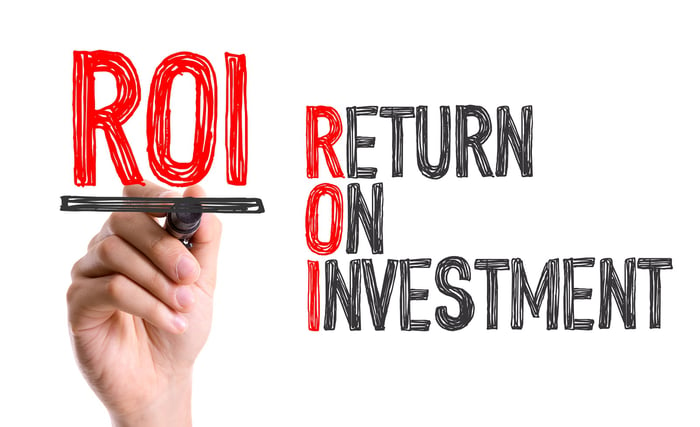When you spend money on marketing for your B2B manufacturing company, what kind of return on your investment should you expect? We’ll review how to calculate ROI and what ratio is considered the best for the manufacturing industry.

When someone asks you, “is your marketing working?”, what do you think they’re really asking? They could be asking you if it’s generating awareness of your products and services, or foot traffic, or if it’s generating sales.
When we ask ourselves this question, we want to know if your marketing is effectively generating business in a profitable way. That’s really what sales and marketing are trying to accomplish, after all.
Anyone who is responsible for spending money to generate revenue for their business (e.g. marketers) should have an easy way to know if their activity is getting them business. This is where return-on-investment comes in and why it’s such an important metric for any business activity.
To learn about some of the most essential components of a manufacturing marketing strategy, visit our manufacturing marketing resources page.
How Do You Calculate Marketing ROI?
ROI is calculated using two primary metrics:
- the cost to do something, and
- the outcomes generated as a result
(typically measured in profit, but for this discussion, let’s use revenue).
There are a few challenges with calculating ROI in a manufacturer's marketing strategy.
For one, calculating ROI for marketing efforts can be tricky, depending on how you measure impact and costs.
Secondly, calculating ROI manually for each marketing campaign you embark upon takes time and can require access to company financials.
Lastly, this approach requires patience as it could take a long time, at least several months, to know if a campaign was profitable.
Calculating manufacturer marketing return on investment in the “traditional” way isn’t always practical, so we’ve developed a better method which focuses on one simple metric: the revenue to marketing cost ratio.
What is the Revenue to Cost Ratio?
The revenue to marketing cost ratio represents how much money is generated for every dollar spent in marketing. For example, $5 in sales for every $1 spent in marketing yields a 5:1 ratio of revenue to cost.
What is a Good Marketing ROI for Manufacturers?
A good marketing ROI for Manufacturing Companies is 5:1.
A 5:1 ratio is the middle of the bell curve. A ratio over 5:1 is considered strong for most businesses, and a 10:1 ratio is considerably above the norm. It’s important to note that while achieving a ratio higher than 10:1 ratio is possible, it should never be the expectation.
Why Use A Ratio?
We use ratios because they are easy to understand and easy to apply. Before any marketing activity is started, everyone should understand what revenue it needs to generate to be successful.
As long as the right tracking mechanisms are in place, you can quickly determine if a campaign was successful or not.
What Is Counted As a Marketing Cost?
When calculating your ratio, a marketing cost is any incremental cost incurred to execute that campaign (i.e. the variable costs). This includes:
- Google pay-per-click spend
- display ad spend
- media spend (TV, radio)
- content production costs
- outside marketing costs
- advertising agency fees
Because full-time marketing personnel costs are fixed, they should not be factored into this ratio. The ratio is meant to give campaigns a simple “pass/fail” test, so the costs factored into the ratio should only occur if the campaign runs.
Why Is 5:1 A Good Ratio?
At an absolute minimum, you must cover the cost of manufacturing your product and the cost to market it.
A 2:1 revenue to marketing cost ratio wouldn’t be profitable for many manufacturing companies, as the cost of the materials used in creating the product along with the direct labor costs used to produce the product (also known as cost-of-goods-sold, or COGS) is generally about 50% of the sale price.
For companies that manufacture products, if you spend $1,000 in marketing to generate $2,000 in sales, and it costs $1,000 to make the product being sold, you are breaking even. If you’re only breaking even with your marketing investment, it wouldn’t make sense to continue.
 Companies with higher gross margins don’t need to achieve as many sales from their marketing before they become profitable. Therefore, their ratio is lower.
Companies with higher gross margins don’t need to achieve as many sales from their marketing before they become profitable. Therefore, their ratio is lower.
Meanwhile, companies with lower margins need to stretch their marketing dollars further before it becomes worth doing. Their ratio would have to be higher.
Resource: Cross selling online can help increase customer lifetime value, which lowers your cost-per-acquisition goal.
How Do I Calculate My Target Marketing ROI Ratio?
| Your CEO, or Chief Marketing/Financial Officer will be able to calculate your target ratio. They will factor in the company’s gross margin targets, overhead expenses, and what it takes for money to hit the bottom line, which is the ultimate goal. They should also be able to provide an estimate of how much you should spend on marketing. |
Is Advertising Manufacturing Overhead?No, only costs associated with operating the factory are included in manufacturing overhead. |
For most manufacturing businesses, a 5:1 ratio will be the target. As mentioned above, anything above and beyond that is icing on the cake, so to speak.
Calculating Marketing ROI for Manufacturers
We know it’s not easy to calculate revenue generated for all marketing activities. Certain tactics like trade shows, email marketing, content marketing for manufacturers, video, social media, and display ads are typically for a targeted audience that comes long before a purchase takes place.
In the current climate, marketing software platforms such as Hubspot, Pardot [SalesForce], and Marketo do a good job of solving the problem and connecting early engagement with a prospect to a final sale, but as with a lot of software platforms they are not always perfect.
Just because a marketing activity can’t be measured perfectly, it doesn’t mean it shouldn’t be considered.
Read More: Best Digital Marketing Tactics for Manufacturers
That being said, it’s worth the extra time for marketers to connect the dots between activity and revenue. Technology is always advancing and today’s web analytics software and methodology is continuing to provide meaningful insight for measuring activity over time and across a myriad of devices.
Last but not least, marketing is about generating revenue. Marketers in the manufacturing industry who aren’t serious about tying their activity back to revenue could be missing the bigger picture.
We can’t stress enough the importance of implementing a ratio, and treating it as the “golden metric” for marketing planning and activity. Doing so will focus the team on the ultimate outcome: growing your manufacturing business.
Learn how to determine the best manufacturing marketing budget for your business.
Manufacturing Budget for Marketing
You may also be interested in:
Manufacturing Marketing Library
Manufacturing Marketing: Getting Started with Digital Marketing
Note: This content originally published January 26, 2020 and was updated July 13, 2022.





Agree, disagree, or just have something to add?
Leave a comment below.